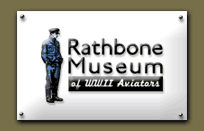 |
|
|
|
 |
|
 |
|
 |
|
 |
|
 |
 |
|
 |
|
|
 |
|
|
 |
|
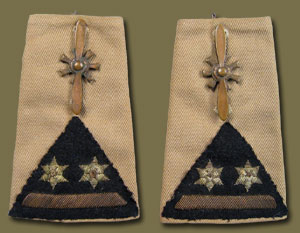 |
|
|
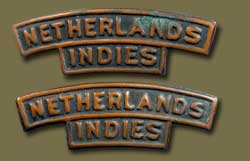 |
|
|
| In 1915, an air service was raised in the Dutch East Indies as part of the colonial army. This was a unique colonial service with its own uniforms and insignia. Most of the insignia shown here is emblimatic of insignia changes made after the fall of the Dutch East Indies and the services regrouping in Australia and Ceylon. The bronze devices above are shoulder titles worn with the khaki uniform. |
|
The KNIL Officer's cap badge as it was changed in 1942. It follows the British pattern closely. |
These slip-on rank devices were designed to wear with a bush jacket or shirt, as was popular with tropical or desert kit. The black triangular rank was adopted in 1942 vs. the more traditional high collar patches worn previously. The rank of one bar and two stars was for Lieutenant Colonel. The bronze prop and engine was a branch of service device. |
|
|
|
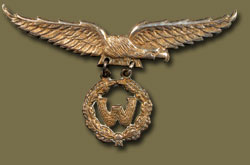 |
|
|
|
 |
|
|
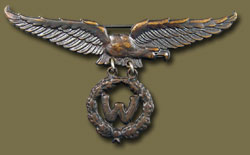 |
|
|
| Observer wing, unmarked, made of thick die-struck bronze metal. |
|
|
 |
|
|
| The flight qualification badges for the KNIL were unique from their Dutch counterparts. The eagle device was for pilots and the wreathed 'W' for observers. This is a pilot observer badge. This example was made locally in Dutch East Indies (now Indonesia) and is unmarked. |
|
When the KNIL retreated from Indonesia, it was determined to raise new squadrons in allied countries to continue the fight. One training facility was in Jackson, Mississippi, USA. This wing was manufactured by Amico in the US for this group. Staff wore American khaki uniforms with KNIL insignia. |
|
|
|
Observer wing, made by Stokes of Australia out of stamped brass |
|
|
|
 |
|
|
|
 |
|
|
| This ID bracelet belonged to the owner of most of the insignia here. His name is Cpt. J. C. Meeowenoord. I have no more further information on him. If you do, please contact me. |
A WWII grouping of Netherland's medals. From l-r, The Order of Orange-Nassau, Officer; WWII Commemorative Cross with two campaign bars; Cross for Order and Peace 1939-45 with three campaign bars. |
|
|
|
|
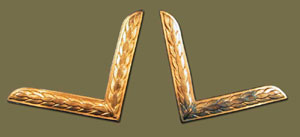 |
|
|
|
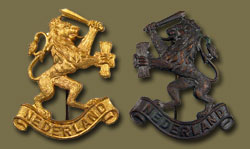 |
|
|
| These gold frames are for field grand and higher officers to wear on ceremonial dress. They were not worn on combat or field dress. |
|
|
|
These Dutch lions came with the insignia and I am not sure how they were used. They are high quality, large and pin-backed. The gold was probably for service dress, the bronze for field dress. |
|
|
|
|
|
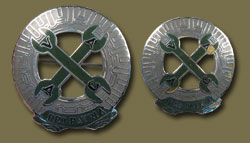 |
|
 |
|
|
 |
|
|
These IDs have been identified by Tristan Broos of www.livinghistory.nl . They are for the Womans Vehicle Corps (Vrouwen Automobiel Corps = V.A.C.) founded in 1940. These women volunteerd for the VAC acting as chauffeurs, driving KNIL forces to their destinations and delivering army supplies. When war broke out they got other jobs, because the Dutch East Indian government didn't believe women where able to do their work in war circumstances.(too dangerous)
The larger badge was worn on both sides of the VAC servicedress collars. The little one on the tie. There is a much larger badge with the same emblem which was worn on the khaki tropic sunhelmet. |
|
|
|
|
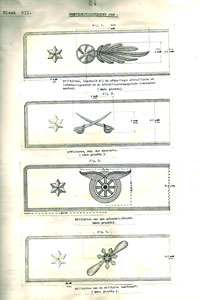 |
|
 |
|
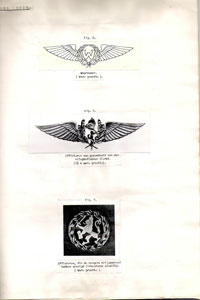 |
|
|
| These pages are from a guide on KNIL inisignia. These are various collars with branch of service devices and colored piping. Thanks to Dennis de Leeuw for these images. |
|
A description of the pilot wing, pilot observer wing, instructor badge and commemorative medal for school. |
|
The observer wing and flight surgeon wing. |
|
|
|
|
|
|
|
| All images © 2000-2004 Tod Rathbone |
|
|
|
|
|
|
|
|
|
|
|
|
|
|
|
|
|
|
|
|
|
|
|
|
|
|
|
|
|
|
|
|
|
|
|
|
|
|
|
|
|

























